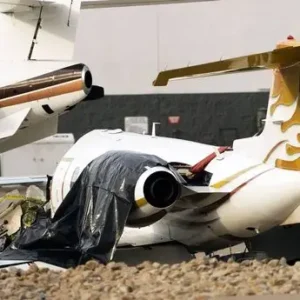Tragic Rockwell Commander Crash in Georgia Another Grim Reminder of Aviation Risks
In a somber reminder of the inherent risks of air travel, a small private aircraft has once again fallen from the sky in the United States. This time, a Rockwell Commander plane lost contact shortly after taking off from Covington Municipal Airport in Newton County, Georgia, and was later found crashed in nearby woods—resulting in the tragic deaths of both passengers on board. The incident adds to a growing list of aviation mishaps that have left many questioning the safety of private air travel, even as commercial flights remain among the safest modes of transportation.
The Incident Unfolds
On the evening of February 15, the Rockwell Commander plane took off from Covington Municipal Airport around 11:00 p.m. The aircraft, piloted by a private captain with only one other passenger on board, appeared to be on a routine flight. However, approximately twenty minutes after takeoff, air traffic controllers lost contact with the plane. Alarm bells immediately went off, and a swift search was launched to locate the missing aircraft.
According to a statement released by the Covington Police Department, officers discovered the plane a short distance from the end of the runway, nestled in the dense woods just north of the airport. The investigation revealed that the aircraft had crashed, and tragically, both individuals on board were found unresponsive at the scene. “There was no further communication from the aircraft after takeoff. Officers located the aircraft in the woods just north of the runway. Two individuals were located with the aircraft and were pronounced dead at the scene,” the statement read.
At this point, the identities of the victims have not been disclosed. The Rockwell Commander, a small, nimble plane known for its use in private aviation, now joins a series of aviation tragedies that have recently made headlines across the nation.
A Pattern of Recent Aviation Disasters
This small plane crash in Georgia is not an isolated incident. Over the past few months, the United States has witnessed several aviation disasters that have collectively shaken public confidence in certain aspects of air travel. One of the most severe was the tragic midair collision between an American Airlines passenger jet and a U.S. Army Black Hawk helicopter near Washington, D.C., an event that resulted in 67 fatalities and left the nation reeling. Additionally, a medical plane crash in Philadelphia claimed the lives of seven individuals, while a small plane that had gone missing over Alaska’s Bering Sea was later discovered to have crashed near Nome, leaving 10 people dead.
Though commercial airline travel is still statistically the safest mode of transportation, these events have contributed to a growing sense of unease about the overall safety of aviation, especially when it comes to smaller, private aircraft. The recent series of incidents underscores the importance of rigorous safety measures and continuous improvements in aviation technology and regulatory oversight.
The Mechanics of the Crash
While the exact cause of the Rockwell Commander crash in Georgia remains under investigation, early reports suggest that the aircraft may have encountered technical difficulties shortly after takeoff. The National Transportation Safety Board (NTSB) has confirmed that an investigation into the crash is underway. A spokesperson for the NTSB stated, “NTSB is investigating the February 15 crash of a Rockwell AC11 airplane near Covington, Georgia,” and an investigator is expected to arrive on scene later this afternoon.
Preliminary assessments indicate that the aircraft may have experienced a failure of critical components, though no definitive conclusions have been reached. Investigators are examining factors such as mechanical failure, pilot error, weather conditions, and possible issues with the maintenance history of the aircraft. In similar cases, loss of communication often precedes a catastrophic failure, and it appears that this incident might be no different.
The Role of Private Aviation Safety
Private aviation, while offering unparalleled convenience and flexibility, comes with its own set of challenges. Unlike commercial airlines, which are subject to stringent regulatory oversight and regular maintenance checks, private aircraft can sometimes operate under less rigorous conditions. This disparity can lead to vulnerabilities, particularly if maintenance schedules are not strictly adhered to or if cost-cutting measures impact safety.
The Rockwell Commander is known for its efficiency and versatility in private aviation circles, but like all aircraft, it requires meticulous upkeep. The incident in Covington serves as a reminder that even well-regarded models can encounter catastrophic failures if any link in the maintenance chain is compromised. The aviation community continues to call for enhanced standards and more frequent inspections, especially for smaller aircraft that operate under different regulatory frameworks than their larger commercial counterparts.
Emergency Response and Recovery Efforts
The response to the crash was swift and coordinated. As soon as air traffic control lost contact with the aircraft, emergency services were mobilized. Local law enforcement, firefighters, and FAA investigators converged on the area in record time. Despite the challenging terrain—dense woods just outside the airport—the Covington Police Department and volunteer fire crews managed to locate the wreckage within a relatively short period.
According to the police statement, the search and recovery efforts took several hours, during which time the team worked diligently to secure the scene and recover the bodies of the victims. This level of prompt response is critical in aviation accidents, where every minute counts in preventing further loss and preserving evidence that could help determine the cause of the crash.
The Human Toll and Community Impact
The tragic loss of life in this small plane crash has left a deep mark on the local community in Newton County. While the victims remain unidentified at this stage, the sorrow felt by their families and friends is immeasurable. Incidents like these not only disrupt the lives of those directly involved but also send ripples of grief throughout the community.
Local residents, as well as those in the broader aviation community, are now calling for a thorough review of safety protocols at smaller airports. The incident highlights the vulnerabilities that can exist even in seemingly routine operations and underscores the importance of investing in safety and training for all aspects of aviation.
Public Perception of Aviation Safety
Over the years, air travel has been statistically one of the safest modes of transportation. However, the recent spate of aviation incidents—ranging from major commercial disasters to small private plane crashes—has begun to shift public perception. For many, the comfort derived from the notion of air travel’s safety is now tempered by a growing awareness of the inherent risks involved, particularly in the realm of private aviation.
This shift in perception is likely to have broader implications. As more incidents come to light, there may be increased pressure on regulatory bodies such as the FAA to tighten safety standards, enhance oversight, and invest in newer technologies that can prevent similar tragedies in the future. The hope is that by learning from these incidents, the industry can continue to improve safety protocols and restore public confidence in all forms of air travel.
Looking to the Future: Steps Toward Prevention
While the investigation into the Rockwell Commander crash is still underway, there are already calls for concrete measures to prevent future occurrences. Aviation safety experts are urging a comprehensive review of maintenance practices, pilot training programs, and regulatory oversight for private aircraft. Some key recommendations include:
- Enhanced Maintenance Standards:Ensuring that all private aircraft undergo regular, rigorous inspections by certified professionals.
- Stricter Regulatory Oversight: Revisiting the standards set for private aviation to align them more closely with those for commercial flights.
- Improved Pilot Training: Mandating additional training for pilots operating private aircraft, with an emphasis on emergency procedures and mechanical troubleshooting.
- Advanced Monitoring Technology:Integrating state-of-the-art monitoring systems that can detect early signs of mechanical failure, allowing for timely intervention before a critical breakdown occurs.
Such measures could significantly reduce the risk of similar tragedies in the future and help restore confidence in the safety of private air travel.
The Legal and Economic Ramifications
The fallout from this tragic accident extends beyond the immediate loss of life. Legally, the investigation could lead to significant changes in how safety regulations are enforced at smaller airports. If mechanical failure or pilot error is found to be a contributing factor, there could be sweeping regulatory changes aimed at preventing future incidents.
Economically, the incident may have an impact on the private aviation industry. News of a fatal crash can lead to increased scrutiny, which might, in turn, raise operational costs for private aircraft owners due to more frequent inspections and stricter maintenance requirements. However, if the industry can implement these changes effectively, it may ultimately result in a safer and more reliable system—benefiting both operators and passengers in the long run.
Community and Family Reactions
In the immediate aftermath of the crash, community leaders and local officials have expressed deep sorrow for the loss of life. Families affected by the tragedy are now faced with the painful process of coming to terms with an unexpected and devastating event. Support services have been mobilized to provide counseling and assistance, ensuring that those impacted by the crash receive the help they need during this difficult time.
The incident has also sparked an outpouring of empathy and concern on social media, where users have shared their condolences and reflections on the fragility of life. One user poignantly remarked, “Every crash, no matter how small, reminds us of how precious life is.” Such comments serve as a reminder that behind every headline, there are real people grappling with profound loss.
The Role of the National Transportation Safety Board (NTSB)
At the heart of the investigation into the Rockwell Commander crash is the National Transportation Safety Board (NTSB). Tasked with uncovering the cause of aviation accidents and recommending improvements, the NTSB plays a crucial role in ensuring that lessons are learned from each incident. As an NTSB investigator is expected to arrive on scene later today, the focus will be on piecing together the sequence of events that led to the loss of control of the aircraft.
The NTSB’s findings could have significant implications, potentially prompting updates to safety protocols not just for private aviation but across the board. Their work is essential for preventing future tragedies and ensuring that every investigation contributes to a safer, more reliable air travel system.






